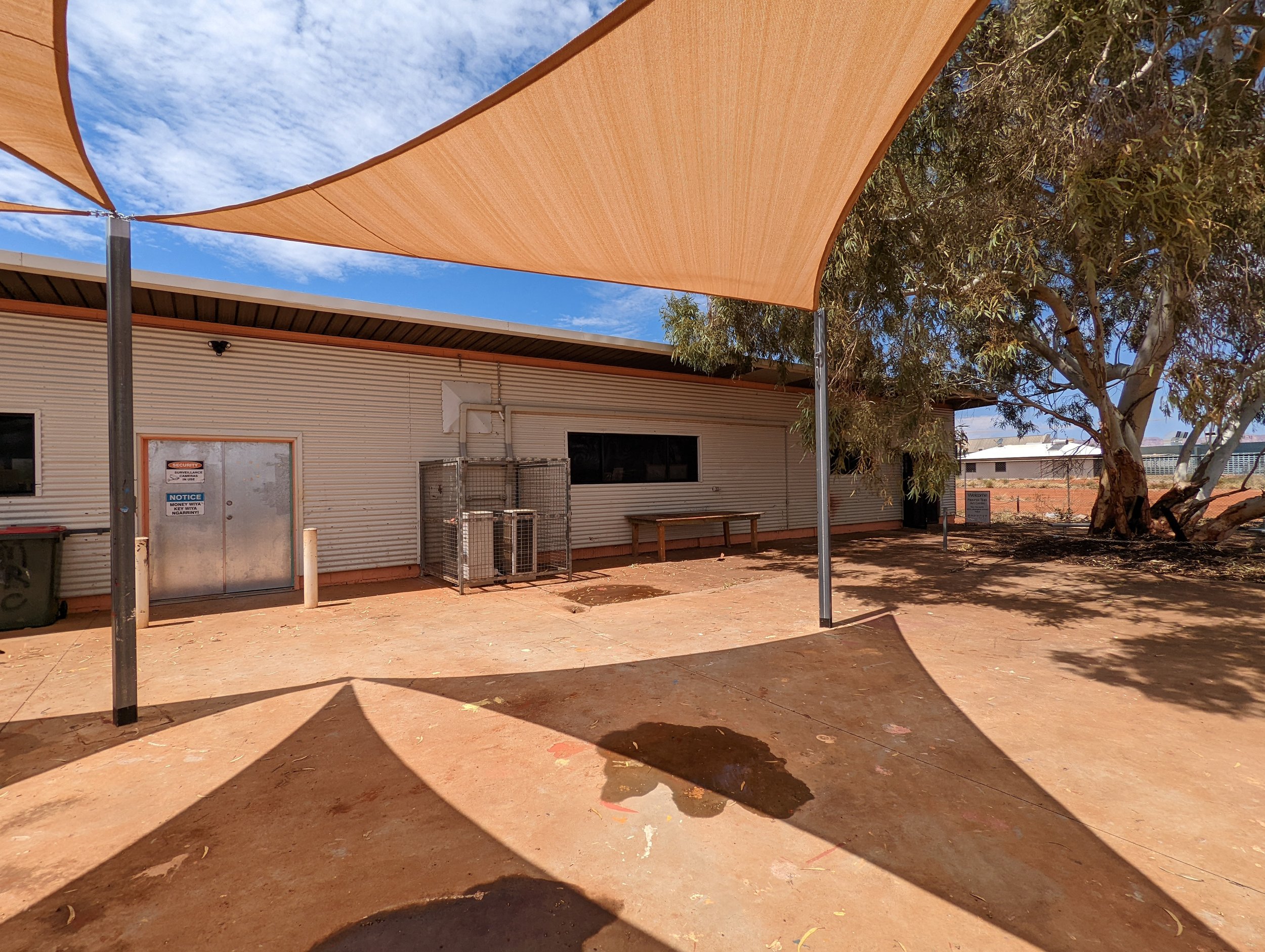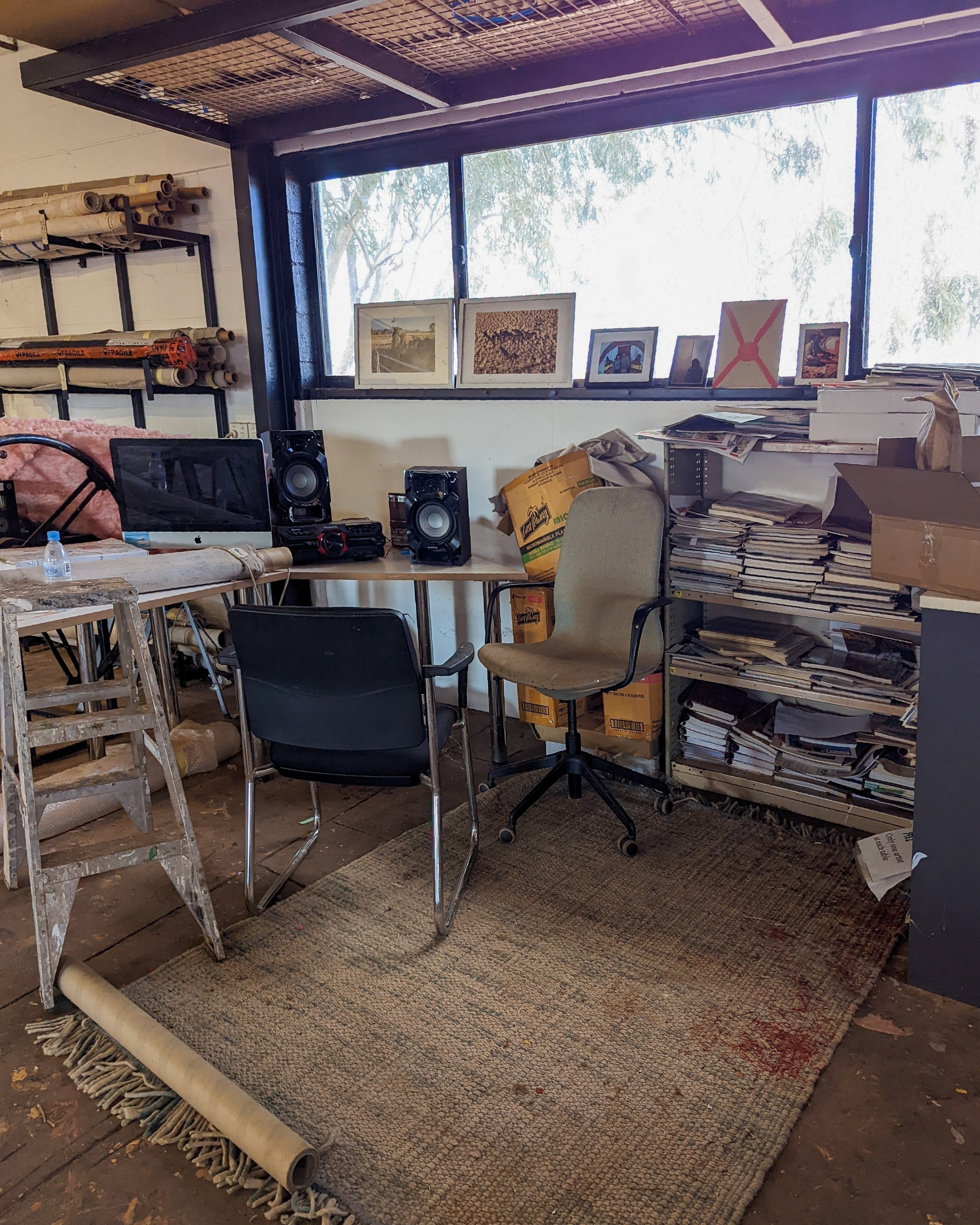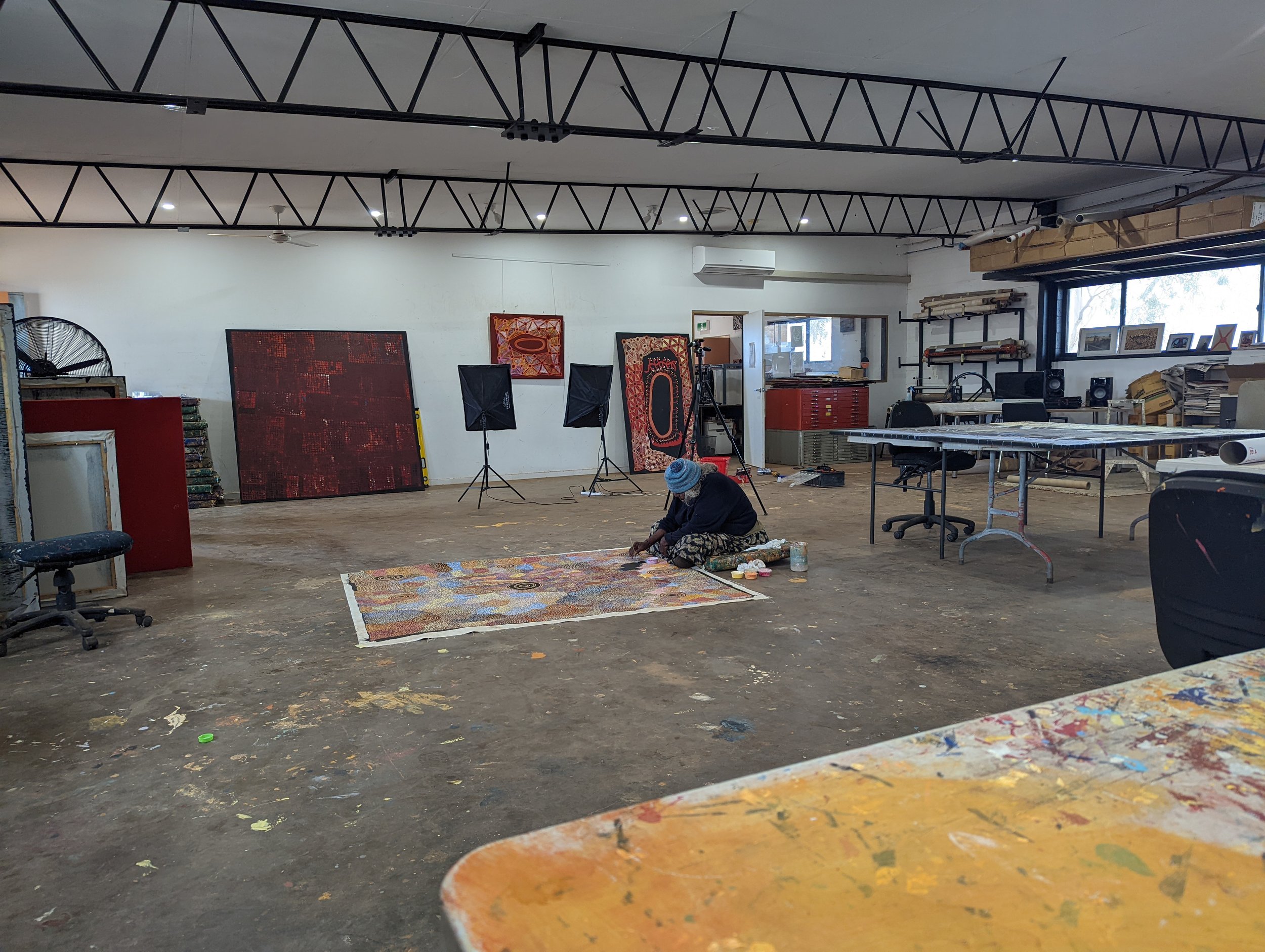
Case Study:
Papunya Tjupi Arts, Papunya
Papunya, known locally as Warumpi, is now home mainly to Luritja speakers along with Pintubi, Warlpiri, Arrernte, Anmatyerr and Kukatja. Warumpi derives from the Luritja word for a "honey-ant dreaming site", Warumpinya, which lies nearby. Papunya sits on the eastern fringe of the Tanami Desert, 250km northwest of Alice Springs/Mparntwe.
Capturing the distinctive landscape, Albert Namatjira painted his last works at and around Papunya before his death in 1959. The presence of the famous artist encouraged others and by 1971 there were many of the now famous artists working – Kaapa Tjampitjinpa; Tim Leura Tjapaltjarri; Turkey Toslon Tjupurrula; Clifford Possum Tjapaltjarri; Billy Stockman Tjapaltjarri; Long Jack Phillipus Tjakamarra; Johnny Wangkula Tjupurrula. With the support of Geoffrey Barden, who introduced ‘Western art materials’, artists and Elders from the various language groups established Papunya Tula Artists. It was the first Aboriginal-owned collective dedicated to the production of works for a commercial market and launched the now renowned Western Desert Art Movement. As Vivien Johnson says, the artists fuse elements of geography (dreaming sites); history (events in the Ancestral past) and ceremony (ritual enactments of events) into one visual image. The distinctive brilliance of the paintings firmly asserted Aboriginal art’s place in contemporary art.
In 1981 there was an exodus of the Pintupi west to their homelands, first to Kintore (Walungurru) and later farther west at Kiwirrkura, where the artists and the company continue to flourish. After Papunya Tula had officially departed Papunya in the early 90’s, Warumpi Arts was established in Alice Springs by the Papunya Community Council. It represented artists from the community who continued to paint, including women, who were coming to the fore, but it closed in 2004. In 2007, the street names of Papunya were changed to those of the famous artists.
In October 2005 the Papunya artists approached Professor Vivien Johnson who had long been involved with the community to help them establish an art centre in Papunya. 25 artists signed the paperwork to become the founding directors of the company which was formally established in 2007. The name was suggested by Sammy Butcher (of Warumpi Band fame) and was also the name of his band at the time. With the help of UNSW and sales from exhibitions, they initially rented various Department of Education houses as a space to gather and work and for art centre managers to live. The Papunya Council then bequeathed the Old Garage which became the art centres’ home.
The artists have established their own identity based on the legacy of their famous forefathers. As Papunya Tjupi Arts states, the art centre is not only about producing art – protected from commercial exploitation – and having a building. Central to Papunya Tjupi Arts is the understanding that painting is an important part of Culture and connection to Country, and that the teaching and passing of knowledge is what keeps the community’s future strong.
For further details of the history of the art movement in Papunya and the establishment of Papunya Tjupi see Vivien Johnson’s book Streets of Papunya: The reinvention of Papunya painting, 2016.

I sat in the back of an NT Music “troopie” appreciating the expertise with which the driver navigated the unsealed road we were travelling. She hit the right speed over the patches of corrugation caused by rain over the wet season and picked a line that avoided the diverts making the drive as smooth as it could be. The MacDonald Ranges were off to our left for most of the journey. It was the 23 September 2022 and I was going out from Mparntwe / Alice Springs to help at the Bush Bands Homegrown event before staying on in the community to spend a few days at Papunya Tjupi art centre.
We arrived at the Papunya store and it seemed to be the nexus of activity. Outside community sat or milled around – Elders, children and dogs scurrying – full cars and trucks pulled up, often with music pumping, greetings and news being shared. Inside shopping trolleys were filled with food for households; arms were laden with drinks or ice-creams to ease the days heat; hot lunch served in take away containers from the counter; transactions were done.
Most of the people we were looking for were there already or soon arrived. There was much chatter about the weekend of music that lay ahead and plans were being made for the set up. This was the home of the Warumpi Band whose songs “Blackfella/ Whitefella” and “My Island Home” had filled the airways of the 1980’s and 90’s, and who are the subject of a film and now theatre production. Sammy Butcher, the main surviving member of the band, was a strong presence along with the next generation of musical talent.
Our accommodation was a series of porta-cabins with bedrooms and bathrooms arranged around an open communal space all covered by a large shading roof. While we made dinner the sound of singing from the Lutheran church group was clearly audible. After dark we lent a hand to set up sound equipment on the basketball court for a series of gigs by local bands. One of Sammy’s grandchildren who was about 9 or 10 years old, played at the drumkit during sound check as though he had been born with drum sticks in his hand. News of the gig starting seemed to spread, and people and cars emerged out of the darkness of the desert and the music played until dawn-break.
The team was up early to set up for Bush Bands, trying to get as much done before the heat of the day made action and outside work gruelling. The Warumpi stage built a few years ago with its large mural sits adjacent to the oval and basketball court. The musicians – some old legends, others the new stars – came for sound checks and I got a preview of what was to come later that night. Mid-afternoon I escaped the heat and joined a gathering of all ages to watch Geelong play the Sydney Swans in the AFL Grand Final on a large TV in the Maku Shed, a community space.
From about 6pm the crowds started to arrive, slowly at first and then in numbers, many driving from communities across the Western Desert. A roster of bands would play until midnight, ranging from rock music to reggae that got the young crowd twerking with impressive vigour. The energy and enthusiasm was infectious and would remain in the air for many days.
When I arrived at Papunya Tjupi first thing on Monday morning, I discovered that the art centre had to close unexpectedly for the day. I had a quick look around then sat at the store and had a yarn with some locals about the impromptu gigs I had heard playing the night before. I spent the afternoon in my donga reading Vivien Johnson’s Streets of Papunya, the important legacy of this place and people coming alive. Camp dogs and the odd person wandered through the otherwise empty accommodation cluster that sat to the edge of town and felt eerily isolated and foreign for someone not used to desert communities.
The next morning I walked to a small hill that provided a view back over the township and the MacDonald Ranges in the distance gaining a perspective on this vast landscape. The following day the artists returned and I saw the art centre in action, although it had to close again the next day. I witnessed a gathering of Elders and artists coming together to discuss plans and what they wanted to do. Agreements were reached and the mood lifted, laughing returning.
Sound check for Bush Bands on the Warumpi stage in Papunya
Artists sitting out the front of Papunya Tjupi Arts discussing plans

Above: View of the front of the building, with the steel artist door to the left and visitor entrance to the far right near the tree (below). Artists sit beneath the shade structures and paint when the weather is comfortable
Architecture
In 2009 Papunya Tjupi moved into the former community garage and workshop. It was one of the original concrete block buildings constructed in 1958/59 by an Indigenous and non-Indigenous workforce that included some of the fathers of the Papunya Tjupi artists and the original Papunya Tula art movement. It first operated as the community store then as a garage but in recent years had become a ‘snake infested asbestos ruin’ as Vivien Johnson said in her book Streets of Papunya. She reports it was without natural light, air conditioning, running water, power, toilets and had not been painted since first built. Initially the art centre could only afford to paint inside, and pressure hose the grease off the floor. Over the following four or five years the building was renovated in stages as money became available, installing windows and skylights; inside and outside toilets; an office, gallery and workspace for stretching canvas; a kitchenette and internal fit outs of shelving and storage. Externally a covered verandah was added and a fence placed around the site.
The art centre now comprises the main arts studio in the original building and to the rear, a stand-alone toilet block and a demountable housing the men’s space with a covered verandah. A paved area with shade cloth above, located between the building and street provides a space for artists to work. Adjacent, is a place to sit beneath the eucalyptus trees. The building works have been achieved with funding from ABA and various other grants.
1. Main Studio
2. Art preparation room
3. Office
4. Retail gallery
5. Covered outdoor working space
6. Toilets
7. Men’s Shed
8. Shipping container storage
Right: The large open studio workshop space, with an office and the art preparation space at the far end. Windows between these spaces maintains visual connectivity throughout. The artist’s studio space feels relatively large and generous with windows either side and good ceiling heights. It is occupied with moveable furniture that can be reconfigured as needed and has a kitchenette to the right.
The shed aesthetic with the exposed trusses has been complemented with simple detailing around doors, storage units and the kitchenette. The fit-out and furniture primarily uses black steel and black laminated plywood. The gentle slope in the ceiling has been used to gain additional storage with two large racks attached above the windows. One holds boxes with art supplies, the other camping equipment for bush trips (left of picture). Under one, is a rug with chairs, desk and a bookshelf creating a mini-library and reference space (below).
Artists paint on the floor or at tables, with family and community also congregating or visiting. Artwork photography was also done against one of the blank walls.
The retail gallery has paintings hung on the walls and laid out on tables for visitors to go through. Supplies for packing and mounting are stored efficiently beneath, in specially designed furniture. A visitor kitchenette and bathroom is located to the back of the space. The space is illuminated with downlights, and a couple of spotlights.
A covered outdoor space is created for artists to work between the main workshop / studio and the mens shed
Looking back across the site of Papunya Tjupi with the men's shed on the right, amenities on the left and the main building behind
The men’s shed occupies a demountable with a verandah added to one side that provides an outdoor covered space. The artists were sitting inside on my visit, enjoying the air conditioning. Parts of the buildings and cars in the art centre precinct were painted.
Car bonnets rest against the verandah of the Men's Shed at Papunya Tjupi Arts ready to be painted. A ramp to the right allows access.















